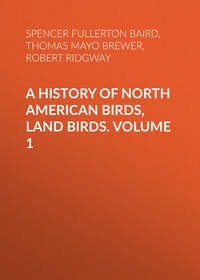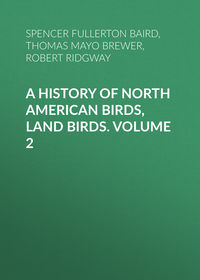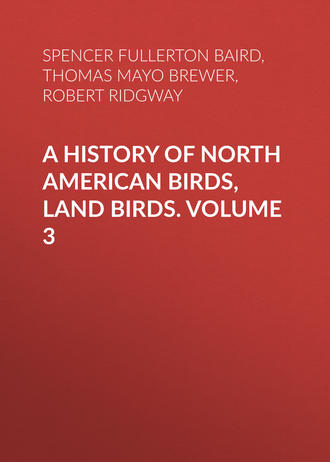 полная версия
полная версияПолная версия
A History of North American Birds, Land Birds. Volume 3
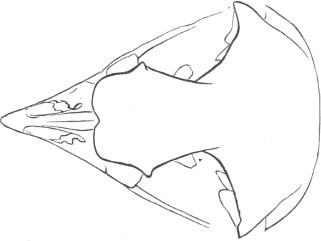
628.
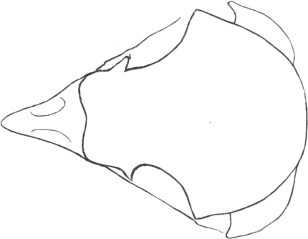
7897.
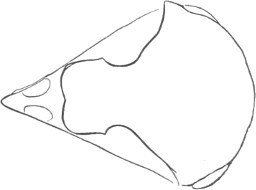
437.
7449. Strix pratincola. Natural size.
4886. Otus wilsonianus. Natural size.
7272. Scotiaptex cinereum. Two thirds.
7899. Nyctale richardsoni. Natural size.
414. Scops asio. Natural size.
773. Bubo virginianus. Two thirds.
628. Nyctea nivea. Two thirds.
7897. Surnia ulula. Natural size.
428. Glaucidium ferrugineum. Natural size.
437. Spheotyto hypogæa. Natural size.

7449.
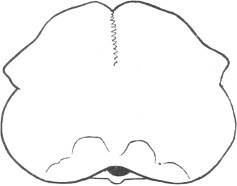
4886.

7272.
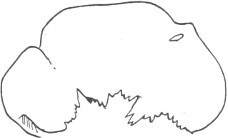
7897.
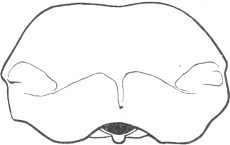
414.
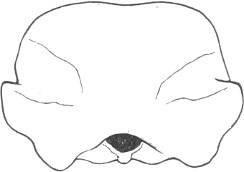
628.
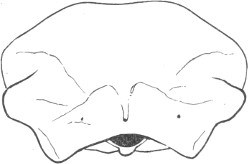
773.

7899.
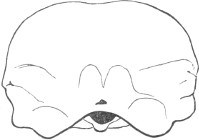
437.

428.
7449. Strix pratincola. Natural size.
4886. Otus wilsonianus. Natural size.
7272. Scotiaptex cinereum. Two thirds.
7899. Nyctale richardsoni. Natural size.
414. Scops asio. Natural size.
773. Bubo virginianus. Two thirds.
628. Nyctea nivea. Two thirds.
7897. Surnia ulula. Natural size.
428. Glaucidium ferrugineum. Natural size.
437. Spheotyto hypogæa. Natural size.

7449.
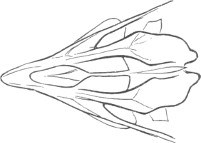
4886.
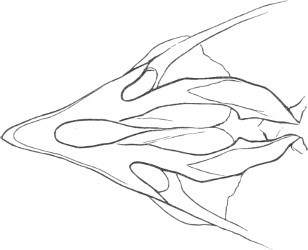
7272.
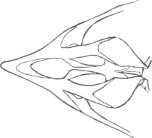
7899.
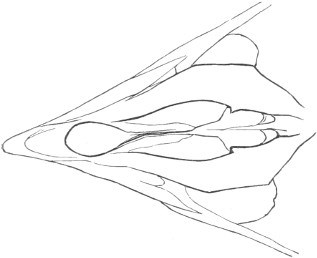
733.
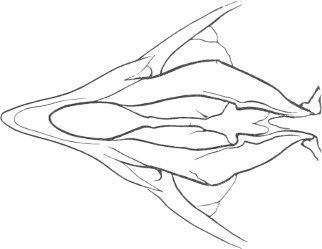
628.
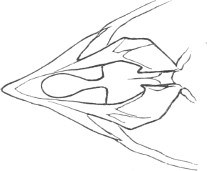
7897.
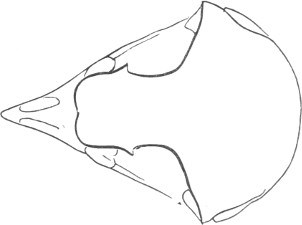
414.
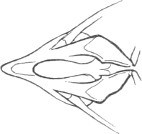
437.

428.
7449. Strix pratincola.
4886. Otus wilsonianus.
7272. Scotiaptex cinereum.
7899. Nyctale richardsoni.
414. Scops asio.
773. Bubo virginianus.
628. Nyctea nivea.
7897. Surnia ulula.
428. Glaucidium ferrugineum.
437. Spheotyto hypogæa.
(All natural size.)

12088.
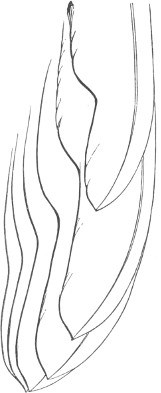
504.
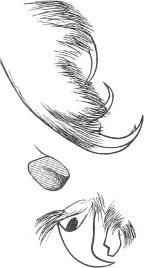
49808.
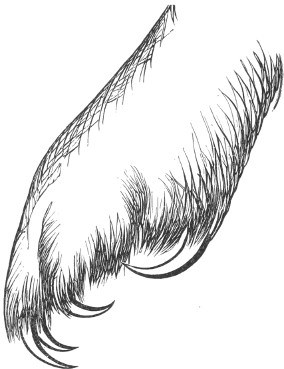
504.
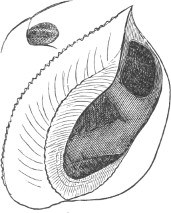
A.
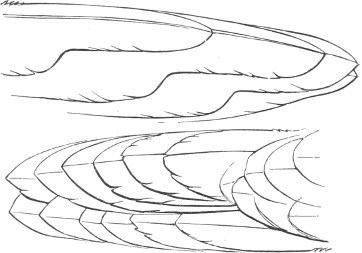
49808.
12088. Nyctea nivea. (Ear copied from Swainson, F. B. A)
504. Scotiaptex cinereum.
49808. Surnia ulula. (Ear copied from Swainson.)
A. Brachyotus “cassinii.” (Left ear and nostril, from fresh specimen.)
Family FALCONIDÆ.—The Falcons
Char. Eyes directed laterally, and eyelids provided with lashes. Toes invariably naked, and tarsus usually naked and scutellate (feathered only in Aquila and Archibuteo). Outer toe not reversible (except in Pandion). Head never with ear-tufts, and never wholly naked (except in the Vulturinæ, of the Old World).
The above characters are about the only readily observable points in the external anatomy in which the Falconidæ differ strikingly from the Strigidæ and Cathartidæ, and may serve to distinguish the birds of this family from those of the two others. The osteological characters, however, as expressed on page 1328, are more decided and important in a taxonomic point of view, and serve to separate the Hawk family as a well-defined group.
In the following treatment of the North American Falconidæ, I confine that part relating to the systematic arrangement strictly to the species embraced within the province of our work, for the reason that in a forthcoming monograph of all the American species I hope to present a systematic classification based upon the species of the whole world. All preliminary details regarding the general characteristics and distinctive peculiarities of the family, as well as all discussions and generalizations upon the subject, will therefore be omitted here.
The following synopsis of the North American genera is intended as an artificial arrangement which may enable the student to identify, by simple and readily understood characters, the forms belonging to this country.40
Genera
A. Nasal bones almost completely ossified, the nostril being a small orifice, with a conspicuous central bony tubercle; its form nearly or quite circular, or linear and oblique (in Polyborus), with its upper end the posterior one Falconinæ.
1. Falco. Nostril circular. Commissure with a prominent tooth and notch; lower mandible abruptly truncated and notched. Primaries stiff and hard, and more or less pointed, the first to the second longest, and the outer one or two with their inner webs cut, the angular emargination being near the end of the quill. Middle toe much more than half as long as the tarsus; claws strongly curved, very acute.
2. Polyborus. Nostril linear, oblique, the upper end the posterior one; commissure without prominent tooth nor notch; lower mandible not distinctly truncated or notched. Primaries soft, obtuse, the third longest, and the outer four or five with their inner webs cut, the shallow sinuation being toward the middle of the quill. Middle toe less than half the tarsus; claws weakly curved, very obtuse. Face and cheeks naked, and scantily haired.
B. Nasal bones very incompletely ossified, the nostril being a large, more or less oval, opening, of oblique direction, its lower end being invariably the posterior one; without a bony tubercle, and never perfectly circular. (Accipitrinæ.)
a. Sides of the head densely feathered close up to the eyelids.
3. Pandion. Outer toe reversible; claws contracted and rounded on their under surface, and not graduated in size.41 Wing long, third quill longest; outer four with inner webs emarginated. Tail rather short, rounded.
4. Nauclerus. Outer toe not reversible; claws not contracted or rounded on under side, and graduated in size. Wing long, third quill longest; outer two with inner webs sinuated. Tail excessively lengthened and forked, the lateral pair of feathers more than twice as long as the middle pair.
b. Sides of the head with a more scantily feathered orbital space, with a projecting superciliary “shield” covered with a naked skin.
* A well-developed membrane, or “web,” between the outer and middle toes at the base.
† Tarsus about equal to the middle toe.
§ Claws short and robust; two outer quills with their inner webs cut.
5. Ictinia. Commissure irregularly toothed and notched; front of tarsus with transverse scutellæ. Tail emarginated; third quill longest.
6. Elanus. Commissure without irregularities; front of tarsus with minute roundish scales. Tail double-rounded; second quill longest.
§§ Claws long and slender; five outer quills with inner webs cut.
7. Rostrhamus. End of bill bent downward, with a long pendent hook; inner edge of middle claw slightly pectinated, or serrated. Tail emarginated; third or fourth quill longest.
†† Tarsus very much longer than the middle toe.
¶ Front of tarsus unfeathered, and, with the posterior face, covered with a continuous series of broad transverse scutellæ.
α. Form very long and slender, the head small, the tail and legs long and claws excessively acute; bill weak, compressed, very high through the base, the culmen greatly ascending basally, and the cere much arched; commissure usually with a very prominent “festoon.”
8. Circus. Face surrounded by a “ruff” of stiffened, differently formed feathers, as in the Owls. Tarsus more than twice as long as the middle toe. Wing very long, hardly concave beneath; third to fourth quill longest; outer four with inner webs sinuated.
9. Nisus. Face not surrounded by a ruff. Tarsus less than twice as long as the middle toe. Wing short, very concave beneath, the outer quill much bowed; third to fifth quills longest; outer five with inner webs sinuated.
β. Form short and heavy, the head larger, the tail shorter, the legs more robust. Bill stronger, less compressed, lower through the base, the upper outline less ascending basally, and the cere less arched. Commissure variable.
10. Antenor. Form heavy, the wings and tail moderately long, and feet very robust; bill rather elongated, the commissural lobe prominent, and the base of the culmen somewhat depressed. Fourth quill longest; outer five with inner webs cut. Lores naked, and almost destitute of bristles.
11. Onychotes. Outstretched feet reaching beyond end of tail; tibial plumes short, close, not reaching below the joint. Wing short, rounded, very concave beneath, the fourth quill longest; outer five with inner webs sinuated. Tail short, but little more than half the wing, slightly rounded. Claws very long, and extremely acute.
12. Asturina. Bill and feet as in Antenor; lores densely bristled; wing short, rounded, concave beneath, the third to fourth quills longest; outer four with their inner webs cut.
13. Buteo. Form of Antenor, but primaries longer and more pointed, the fourth usually longest, and the outer three or four with inner webs cut. Bill and feet as in Asturina. Tail moderate, or rather short, nearly even, or slightly rounded.
¶¶ Front of the tarsus densely feathered down to the base of the toes.
14. Archibuteo. Feathering of the tarsus interrupted behind by a bare strip along the full length; middle toe less than half as long as the tarsus. Nostril broadly oval, obliquely horizontal; bill weak, the upper outline of the cere much ascending basally. Feathers of the nape normal, blended. Third to fourth quills longest; outer four or five with inner webs cut.
15. Aquila. Feathering of the tarsus uninterrupted behind; middle toe more than half as long as the tarsus. Nostril narrowly oval, obliquely vertical; bill strong, the upper outline of the cere nearly parallel with the lower. Feathers of the nape lanceolate, distinct. Fourth quill longest; five to six with inner webs cut.
** No trace of membrane between outer and middle toes.
16. Haliætus. Tarsus feathered in front one third, or more, of the way down; the naked portion with an imperfectly continuous frontal, and less well defined posterior, series of transverse plates, and covered elsewhere with roundish granular scales. Feathers of the neck, all round, lanceolate, distinct. Bill very large, the chord of the culmen more than twice as long as the cere on top; nostril oval, obliquely vertical. Third to fifth quills longest; outer six with inner webs cut. Tail rounded or cuneate, sometimes consisting of fourteen feathers.
The foregoing diagnoses embrace merely the more conspicuous external characters whereby the genera may be most readily distinguished by the student. The following table presents additional accompanying characters afforded by the osteological and anatomical structure, of more importance in defining with precision the several groups embraced in our fauna.
A. Scapular process of the coracoid produced forward so as to meet the clavicle42 (Huxley). Nasal bones almost completely ossified, the nostril being a small, usually circular opening, with a raised or “rimmed” margin, and conspicuous, usually central, bony tubercle. Inferior surface of the supermaxillary bone with a prominent median angular ridge. Superciliary process of the lachrymal consisting of a single piece. (Falconinæ.43)
B. Scapular process of the coracoid not produced forward so as to meet the clavicle (Huxley). Nasal bones incompletely ossified, the nostrils being very large, and without bony rim or tubercle. Inferior surface of the supramaxillary bone without a median ridge. Superciliary process of the lachrymal variable. (Accipitrinæ.)
a. Superciliary process of the lachrymal composed of a single, excessively abbreviated piece;44 posterior margin of the sternum with a pair of indentations, and without foramina. (Pandion and Nauclerus.)
b. Superciliary process of the lachrymal double, or composed of two pieces, joined by a cartilaginous “hinge,” and reaching nearly across the orbit. Posterior margin of the sternum without indentations, and usually with a pair of foramina. (All except Pandion and Nauclerus.)
† Septum of the orbits and nostrils incompletely ossified (the former always and the latter usually) and with foramina; posterior margin of the sternum most produced backwards laterally, and incompletely ossified, there being usually a pair of foramina. Intestinal canal short, broad, with the duodenum simple, forming a single loop (McGillvray). A well-developed “web” between the outer and middle toes. (All but Haliætus.)
†† Septum of the orbits and nostrils completely ossified, and without any trace of foramina; posterior margin of the sternum produced medially into a convex lobe, and without any trace of foramina. Intestinal canal extremely elongated, attenuated, with the duodenum arranged in several convolutions (McGillvray). No trace of a web between outer and middle toes. (Haliætus.)
Subfamily FALCONINÆ
Genus FALCO, Auct
Gen. Char. Bill strong, its breadth at the base equalling or exceeding its height; upper outline of cere on a level with, or rather lower than, the base of the culmen; gonys much arched, the chord of the arch equalling about half that of the culmen. Near the tip of the upper mandible is a prominent tooth on the commissure, and near the end of the lower mandible, which is truncated, is a deep notch corresponding; the end of the upper mandible is compressed, giving the situation of the tooth an inflated appearance when viewed from above. Nostrils circular, with a conspicuous central tubercle. Orbital region bare; projecting superciliary shield conspicuous, arched, but not very prominent. Tail shorter than wing, the feathers hard and stiff. Primaries very strong, elongated, tapering rapidly toward their points; only the first or first and second with their inner webs emarginated, the cutting being angular, and near the end of the quill. Tarsus never with a single series of transverse scutellæ either in front or behind; middle toe very long.
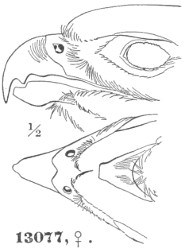
13077, ♀. ½
Subgenera
One primary only with inner web emarginated; first to second longest; first longer than fourth.
Tarsus longer than middle toe, and feathered far below the knee; first quill shorter than third. Coloration of the sexes alike; old and young slightly different in pattern and tints. Size large … Hierofalco.
Tarsus not longer than middle toe, and scarcely feathered below the knee; first quill equal to or longer than the third. Coloration of the sexes alike; old and young very different in pattern and tints. Size, very small to large … Falco.
Two primaries with inner webs emarginated; second to third longest; first shorter than fourth.
Basal joint of toes without transverse scutellæ; tarsus about equal to middle toe.
Coloration of the sexes in adult plumage very different in tints; in the young alike, the young ♂ resembling the adult ♀. Size small … Æsalon.
Basal joint of toes with transverse scutellæ; tarsus longer than middle toe.
Coloration of the sexes very different, in pattern and tints, at all ages; old and young alike. Scutellæ of the toes and tarsus interrupted at the digito-tarsal joint; tarsus much longer than middle toe. Bill small, the cere on top less than one fourth the culmen. Size small … Tinnunculus.
Coloration of the sexes alike at all ages; old and young slightly different in pattern and tints. Scutellæ of tarsus and toes uninterrupted from “knees” to claws; tarsus but little longer than middle toe. Bill large, the cere on top about one third the culmen. Size medium; form very slender … Rhynchofalco.
Subgenus HIEROFALCO, CuvierHierofalco, Cuvier, 1817. (Type, Falco gyrfalco, Linn.)
Jerafalco, Boie, 1822; Kaup, 1851. (Same type.)
Gennaia, Kaup, 1847. (Type, Falco jugger, Gray.)
Species and Races1. F. gyrfalco. Wing, 13.00–17.00; tail, 8.50–11.50; culmen, .85–1.05; tarsus, 2.10–3.00; middle toe, 1.80–2.25.45 Ground-color varying from entirely pure white to wholly dusky, but generally bluish (in adult) or grayish-brown (in young) above, and white beneath. Adult. All the markings transverse.46 No lighter nuchal band. Young. Markings of the lower surface longitudinal, the upper parts without transverse bars (except on the tail47).
a. Lower parts with white predominating, or wholly white.
Lower tail-coverts never with markings. No tinge of blue anywhere on the plumage, the ground-color of which is entirely pure white at all ages.
1. Adult. Upper parts, excepting head and neck, with transverse crescentic bars of dark plumbeous; lower parts immaculate, or else without well-defined markings. Young. Upper parts with longitudinal stripes of dark plumbeous; lower parts usually conspicuously striped. Hab. Greenland (in the breeding-season); in winter, occasionally wandering into the northern portions of Europe and North America … var. candicans.
Lower tail-coverts always with markings. A tinge of ashy-blue more or less prevalent above. Young dusky above.
Head and neck above abruptly lighter than the back. Young plain grayish-brown above, with conspicuous whitish borders to the feathers.
2. Adult. Upper parts white, passing into bluish posteriorly; everywhere (except on head and neck) with sharply defined, transverse (not crescentic, but continuous) bars of dark plumbeous. Abdomen and flanks with transverse spots of the same. Young without irregular light mottling to the plumage above, and with broad longitudinal stripes beneath. Hab. Iceland and Southern Greenland, in the breeding-season; in winter, south into Northeastern United States, and Northern Europe … var. islandicus.
Head and neck above abruptly darker than the back. Young (of var. sacer) variegated grayish-brown above, without light borders to the feathers.
3. Adult. Top of the head streaked with whitish; back with sharply defined, continuous, narrow transverse bars, of creamy-white. Hab. Interior regions of Continental Arctic America (Slave Lake, Yukon, and McKenzie River district) … var. sacer.
4. Adult. Top of head not streaked with whitish; back without sharply defined bars of the same. Hab. Continental Arctic Europe (Scandinavia) and Siberia. Migrating south, in winter, to Bengal (Hardwicke) … var. gyrfalco.48
b. Lower parts with dusky predominating, or wholly dusky.
5. Adult. Almost entirely dusky, without well-defined markings anywhere. Hab. Littoral regions of the Hudson Bay Territory and Labrador … var. labradora.
2. F. lanarius. Wing, 11.50–16.00; tail, 6.60–9.50; culmen, .70–1.00; tarsus, 1.90–2.40; middle toe, 1.65–2.00. Ground-color varying from pale grayish-plumbeous to dark sepia-brown; beneath white, with sparse markings, these coalesced into a broken patch on the flanks. Adult. Above obscurely barred transversely with pale ashy and brownish-dusky, the former prevailing posteriorly, the latter anteriorly; a lighter nuchal band. Spots on the sides and flanks transverse. Young. Above brown, varying from grayish-drab to dark sepia, the feathers usually bordered with paler (rusty in youngest individuals); markings beneath all longitudinal.
a. Outer webs of tail-feathers with large well-defined light spots; outer webs of the primaries sometimes with light spots on the basal portion; secondaries without distinct spots on the outer webs. Lower tail-coverts immaculate.
Wing, 13.65–16.00; tail, 8.40–9.50; culmen, .85–1.00; tarsus, 1.95–2.15; middle toe, 1.85–1.95. Top of the head white, with narrow streaks of dark brown. Hab. Central and Eastern Europe, Western Asia, and adjoining portions of Africa … var. lanarius.49
b. Outer webs of tail-feathers without distinct light spots, or without any at all; outer webs of primaries with no trace of spots; secondaries with light spots on outer webs. Lower tail-coverts sparsely spotted.
Wing, 12.00–14.25; tail, 7.60–9.00; culmen, .75–.90; tarsus, 2.15–2.40; middle toe, 1.70–2.00. Top of head brown, with narrow black streaks. Adult. Above with obscure transverse spots of bluish. Young. Above with feathers bordered with rusty … var. polyagrus.
Wing, 11.50; tail, 6.60; culmen, .70; tarsus, 1.90; middle toe, 1.65. Above uniform dark brown, with a faint plumbeous cast, the feathers without trace of light or rusty edges; outer web of tail-feathers without trace of light spots. Hab. Mexico … var. mexicanus.50
Wing, 13.60–14.30; tail, 8.25–9.00; culmen, .80–.87; tarsus, 1.85–1.90; middle toe, 1.85–1.90. Colors similar to the last; entire auriculars white; mustache narrow and conspicuous. Hab. Southern Asia … var. jugger.51
The only point of difference in the external anatomy between the Lanner Falcons and Gerfalcons consists in the different degree of feathering on the upper part of the tarsus; this is much denser and extends farther down and more around the posterior face in the Gerfalcons, but they, being inhabitants of a very northern latitude, need this protection against the rigor of the climate. These slight specific differences are illustrated by the figures on page 1430. The same difference is observable in many birds whose habitat extends through a great range of latitude, as, for instance, the Pediocætes phasianellus, the northern race of which has the feathers covering the base of the toes so long as to reach beyond the claws and nearly conceal them, while in the southern form (var. columbianus) the toes are almost completely naked.




